What's Next for Fish Finders?by Mr. Wizard24 Sept 1998 |
 |
What's Next for Fish Finders?by Mr. Wizard24 Sept 1998 |
 |


Business Week 28 Sept. 1998 by Miki TanikawaJAPAN MAY BE MIRED IN RECESSION, but that has yet to stop the stream of nifty new gadgets that wind up in the U.S. The latest, Pocket Sonar, is half electronic game and half fish finder.
No, it won't lead you to a plate of sushi. But Pocket Sonar, co-developed by Honda Electronics--which makes fish sonar for professionals--and Bandai Co. --maker of the popular Tamagotchi--aids recreational anglers. Basically a floating device and underwater sensor, Pocket Sonar can detect fish up to 65 feet away. It works with Nintendo's Game Boy: A cassette connected to the sonar device and plugged into the game machine shows any fish swimming by as symbols on a screen.
The 10,000 $110 machines that hit Japanese stores in July already are sold out. And international sales seem certain. After all, Pocket Sonar allows study of the marine landscape and comes equipped with a fish encyclopedia profiling 121 varieties of fish. It's also got this cool game function for the novice angler: Got no bites today? Then switch on the gadget's game function that allows you to snag electronic fish instead.
 In August 2005, we (Polson Enterprises / RBBI) stumbled across this page on the Pocket Sonar product.
In August 2005, we (Polson Enterprises / RBBI) stumbled across this page on the Pocket Sonar product.
Copyright 1998, by The McGraw-Hill Companies Inc.


Nikki Weekly Tuesday, 25 August 1998
| Bandai developed the sonar device with Honda Electronics. A fish-finding sonar device designed to be used in conjunction with Nintendo Co.'s Game Boy hand-held video-game machine has been introduced by Bandai Co.
The device can detect fish up to 20 meters deep when placed on the surface of the water. It provides a readout on the Game Boy screen. The product was developed in cooperation with Honda Electronics Co., which is strong in sonar products, Bandai officials said. They added that the new device costs about a third as much as a comparable sonar device. The product measures only 16cm in length. Price: 14,800 yen ($103).
Copyright 1998 Nihon Keizai Shimbun, Inc. |
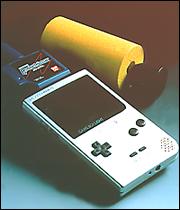 |

******************************************** RBBI Comment - the unit in the story below appears to have been a predecessor to the new unit. ********************************************
TGS: Game Boy 'Gone Fishing'www.next-generation.com 19 March 1998Bandai is marketing a new peripheral for Game Boys that turns the handheld unit into a fully functional fish finder. Anglers who seek an advantage at finding their prey may want to enlist the aid of a new gadget from Bandai. The unit is called the Handy Watcher and it turns the Game Boy display into a fish finder. The peripheral consists of a sensor on a wire and a float that gets submerged within the water. It then senses vibrations and sounds in the immediate area and returns the data to the Game Boy when then indicates at what depth the fish are and in what direction. In addition to this practical application, for those rainy days, the unit also offers a few of its own fishing games. While the games aren't particularly advanced, it is a nice feature all the same. The Japanese price of the unit is a bit steep, 14,800 yen (about $135) and the Bandai spokesperson IGN spoke to about the unit was unsure if it was going to be brought to the US. "We are in talks with a number of US companies about the possibility, but we are concerned about the price point in the US." |
 |

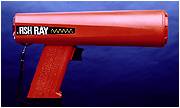 |
Hand Held Ray GunMantasonar has a neat hand held unit resembling ray gun that acts as both a depth finder and a fish finder. A special version is made for use through ice (ice fishing).
|
Multibeam Transducers for 3D ViewsThe Hummingbird web site has some great graphics showing their multibeam transducers used to construct 3D views. |
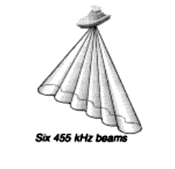 |
 |
Temperature and Light/Lure Color IndicatorFishhawk Electronics Model 530 Temperature and Light/Lure Color Indicator provides instant water temperature reading, plus light/lure color analysis to depths of 200 feet. A weighted probe senses the information at depth while on a digital line counter indicates probe depth. |
CCD CameraThe unit based on Nintendo's Gameboy uses a "plug in" concept that opens it up for additional third party "add ons," some of which already exist. The gameboy CCD camera available in both Japan and the U.S. retails under $50. It doesn't take a wizard to see how cool it would be to take your picture with your fish just after you caught it. This "plug in" concept could revitalize fish finders as we know them. |
 |

Several companies have wearable computers. The units clips on your belt and feed either eyeglass or monocle displays. Information appears suspended in front of the viewer. Many of these units include a CD drive to allow the storage and frequent updating of blueprints, maps, circuit diagrams, parts books, and service manuals.
 |
GlassesMicroOptical Corp is one of many companies involved in making displays of this nature. I visited their website, and "borrowed" this photo of their "glasses". |
The belt worn device would be connected by a cable to a set of glasses similar to the MicroOptical glasses shown above. The use of "heads up" displays to sense the direction you are looking would be tied to the multibeam fish finder transducers allowing the visual projection to seem as if you are actually peering into the water just like my bats found the frogs with their radar. The visual display could indicate the size of the fish by using different symbols as well as provide a zoom mode. The product gives the user the equivalent of Superman's x-ray vision. You can even "see through" the bottom of the boat!
The wearable computer would incorporate a CD drive to access the latest software updates, electronic nautical charts, fishing tips, record fish weights, fish identification tips, local fishing laws, the already existing fishing games to play when actual fishing is not going well, and additional information. Local storage could record earlier fishing locations (gps location), prior catches, and other local information. The information desired could be select by pressing a few buttons on the belt worn computer.
The glasses would use the same "heads up" display technology with the electronic nautical charts to allow you to actually see the charts super-imposed upon the area you are looking at.
It could also drive input/output devices via its wireless link including a cell phone and modem, electronic scales, a shallow depth alarm and the already existing camera. A modem and cell phone allow e-mail access, on-line software updates, and the ability to send the "just taken" photo of your fish to anyone in the world!
By maintaining a "plug in" architecture, the fish finder could be personally adapted to your needs. You purchase only the accessories you want, and buy them from who you want.
Japan has long been captivated by anything about fishing. Combining their obsession with fishing and their obsession for hand held technology may have just broken an established paradigm in fish finders.
 Still A Nonbeliever?
Still A Nonbeliever?5,566,073 This device takes aviational chart data and displays it over your view from an airplane.
5,786,849 This unit displays electronic nautical charts in glasses (binoculars) as an overlay of your actual view.
Fishboy?If anybody thinks this is stretching Nintendo Gameboy technology, take a look at a Gameboy Hardware page. The 1995 Virtual Gameboy was actually a fully 3D version of the Gameboy which immersed the player inside the game! The machine was unpopular at that time because you had to rest your eyes frequently. It sold for less than $150.00. Note its general appearance. Imagine the controls unit being clipped onto your belt, and your there. With the much greater computing power now available, its not a great leap to imagine Nintendo's Gameboy technology beating the earlier vision problems. |
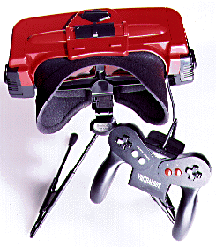 |

 Still A Nonbeliever Part 2?
Still A Nonbeliever Part 2?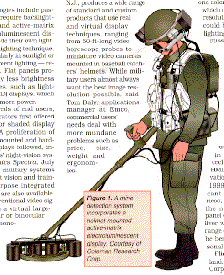 |
Mine Detection SystemThe January 1999 issue of Photoelectronic Spectra pgs. 60-63 describes a military mine detector that utilizes a computer "eyepiece" projection display that allows the user to actually see the underground mine or other buried object projected upon his view of the scene.Flir Systems Inc. of Portland Oregon, Coleman Research Corp. of Orlando FL and Vista Controls of Santa Vista CA developed this system. If you can't foresee this technology being used as a fish finder - you certainly are not Wizard material !!! |

 Eyeglass Mounted Display
Eyeglass Mounted Display
Compact Eyeglass-Mounted Display Adds an Electronic Element to Your Real World View. Research and Developments. by Stephanie vL Henkel. Sensors. June 1999.
Unit from MicroOptical Corp of Westood MA (see photo we posted earlier) allows projectable image to float from 2 feet to infinity in front of viewer by bringing computer images into one lens of a conventional pair of eyeglasses. Monochrome 320 by 240 pixels screen covers 12 degree diagonal of field of view. Color displays with VGA resolution and 15 degree field of view are now being demonstrated.
 Optical Camouflage
Optical CamouflageSusumu Tachi a Tokyo University professor was strongly in the news in March 2003 with a new concept called Optical Camouflage. A photo of a student wearing what appears to be a transparent coat in which you could see three men walking behind him was stunning. A camera to the rear of the student is used as input to a projector which then displays the view on the front of a special coat the student was wearing. This allows you to virtually see through the student. This technology might be used to project the output from the fish finders directly on a portion of the hull to allow you to "see through" the hull without special glasses.
 Wireless, Rod Mounted Fishfinders
Wireless, Rod Mounted Fishfinders13 Oct 2003 - Humminbird Smartcast Wireless Fishfinders were announced in a press release. The system two pieces, a wireless remote castable sonar sensor and a rod mounted fishfinder display (another version is wrist mount). The result is the closest thing yet to our "Virtual Fishfinder" concept. It wont be long now.
 Navigations Systems are Getting Close
Navigations Systems are Getting CloseJuly 2005 Boating Magazine page 64 "Electron Blast" reviews the Northstar 972 navigation system. It allows users to virtually view their position from a height of 200 feet and dive below the surface to look at a riverbed chanel. The report says it can be networked with other 972's, depthsounders, radar, video and PC feeds. We are guessing it can be networked with at least some fish finders. This is beginning to get get pretty interesting. How far off can our virtual fishfinder still be?

 Acoustic Lens Camera Sonar May be the Way
Acoustic Lens Camera Sonar May be the Way
Until next time!
Mr. Wizard



Return to Recreational Boat Building Industry Home Page